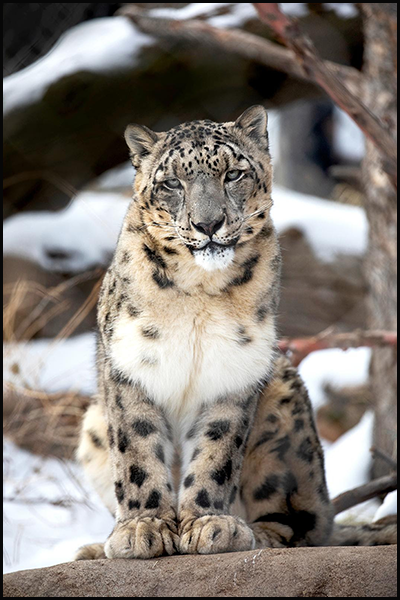Cheyenne Mountain Zoo is celebrating the arrival of a captivating new resident, Valens [VAL-inz], a 5-year-old male snow leopard.
With his big fluffy paws, mesmerizing tail and cautious-yet-inquisitive personality, Valens is living up to his species’ nickname: Ghost Cat. Snow leopards are known for their elusive and stealthy nature, and Valens embodies those traits with a cautious approach to his new surroundings.
“When he’s unsure, he does this adorable hiding behavior that we call his ‘elusive snow leopard mode,’” Basia Dann, lead animal keeper in Asian Highlands, says. “He moves really slowly and stays close to the ground, but his ears stay forward, which means he’s curious and not afraid. You can see he’s carefully assessing everything around him so meticulously.”
Valens is full grown, weighing around 70 pounds, with, “the biggest paws I’ve ever seen on a leopard,” according to Basia. He has also made an impression with his huge, fluffy and animated tail that seems to be in constant motion.
Animal care teams carefully and patiently managed Valens’ journey to his new home to help him settle in confidently. Asian Highland keepers worked with Valens’ former keepers at Central Park Zoo to learn about his favorite enrichment items, foods and hangout spots, which they incorporated into his new habitat to give him a sense of familiarity.
As a naturally cautious animal, they give him the time and space to adjust on his terms and schedule. Valens arrived at CMZoo just before Thanksgiving and started exploring in guest view in early January.
“He’s making great progress, and there’s no rush,” Basia says. “We’re following his lead. He has started training and taking food directly from keepers, as well as exploring more of his yard. We’re proud of him, and we’re going to continue setting up his environment to be comfortable and full of choices for him.”
Guests can visit Valens in Asian Highlands at CMZoo. While he continues to acclimate, he’ll have access to behind-the-scenes indoor dens and outdoor spaces where he’s visible to guests, giving him the choice to explore at his own pace. Keep an eye on the caves and doorways in the south leopard yard, inside the Asian Highlands archway, where he’s likely to be hanging out. Lucky guests might catch a glimpse of him strutting proudly with his latest treat.
“It’s wonderful to have a snow leopard on the mountain,” Basia says. “They are incredible cats, and I’m excited for him to continue getting more comfortable, so he can help us inspire more people to care about his wild counterparts and their habitats.”
Native to the rugged mountain ranges of Central Asia, snow leopards are perfectly adapted to their cold, high-altitude habitats. Their thick fur and long tails help keep them warm, while their oversized paws act like snowshoes, allowing them to navigate deep snow and ice with ease. Known as “ghosts of the mountains,” they are incredibly elusive in the wild, which makes encounters with them a truly magical experience. Discover more about snow leopards at CMZoo












